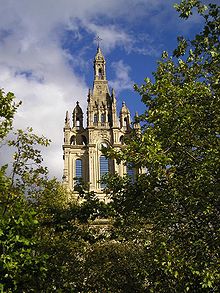Basilica of Begoña
| Basilica of Begoña | |
|---|---|

Steeple of the basilica.
|
|
| Basic information | |
| Location |
|
| Affiliation | Roman Catholic |
| District | Begoña |
| Province | Biscay |
| Country | Spain |
| Year consecrated | 16th centuryAD |
| Ecclesiastical or organizational status | Parish |
| Architectural description | |
| Architectural type | Basilica |
| Architectural style | Gothic and Baroque |
| Specifications | |
| Direction of façade | West |
| Spire(s) | 1 |
| Materials | limestone |
The Basilica of Begoña (or Basílica de Nuestra Señora de Begoña in Spanish) is a basilica in Bilbao, in Spain, dedicated to the patron saint of Biscay, the Virgin Begoña.
The current parish priest is Jesús Francisco de Garitaonandia.
The basilica started life in the 16th century, designed by Sancho Martínez de Arego. It has three naves, to which the addition of vaults was completed in the 17th century in construction work that took a century, having started in 1511. During the time of this work, the Gothic style began to show Renaissance influence, and the arched mid-16th century main entrance reflects the transitional style of the Spanish architect Gil de Hontañón. The remainder of the building remains purely Gothic in style.
During the 19th century, the basilica was damaged as a result of it forming part of Bilbao's city wall. The Carlist General Tomás de Zumalacárregui was fatally injured near the basilica. The current tower and part of the exterior were designed by José María Basterra and built between 1902 and 1907.
On 16 August 1942, an incident between Falangists and Carlists resulted in several grenades exploding near the church. Accounts differ on number of injuries and whether any were killed, but the incident highlighted dangerous rifts between Spanish nationalist factions and prompted a restructuring of Franco's government. A prominent Falangist, Juan José Domínguez, was controversially shot as a punishment for the incident.
Work was carried out to correct the damage, however, and from September 1993 to June 1994, extensive cleaning and restoration work was carried out on the stone and the clock face and bells were repaired. The clock tower houses 24 bells, with the heaviest weighing a tonne, and were built in Sumiswald, Switzerland. The history of the clock tower dates back to 1922, and currently, seven different melodies can be produced.
...
Wikipedia
